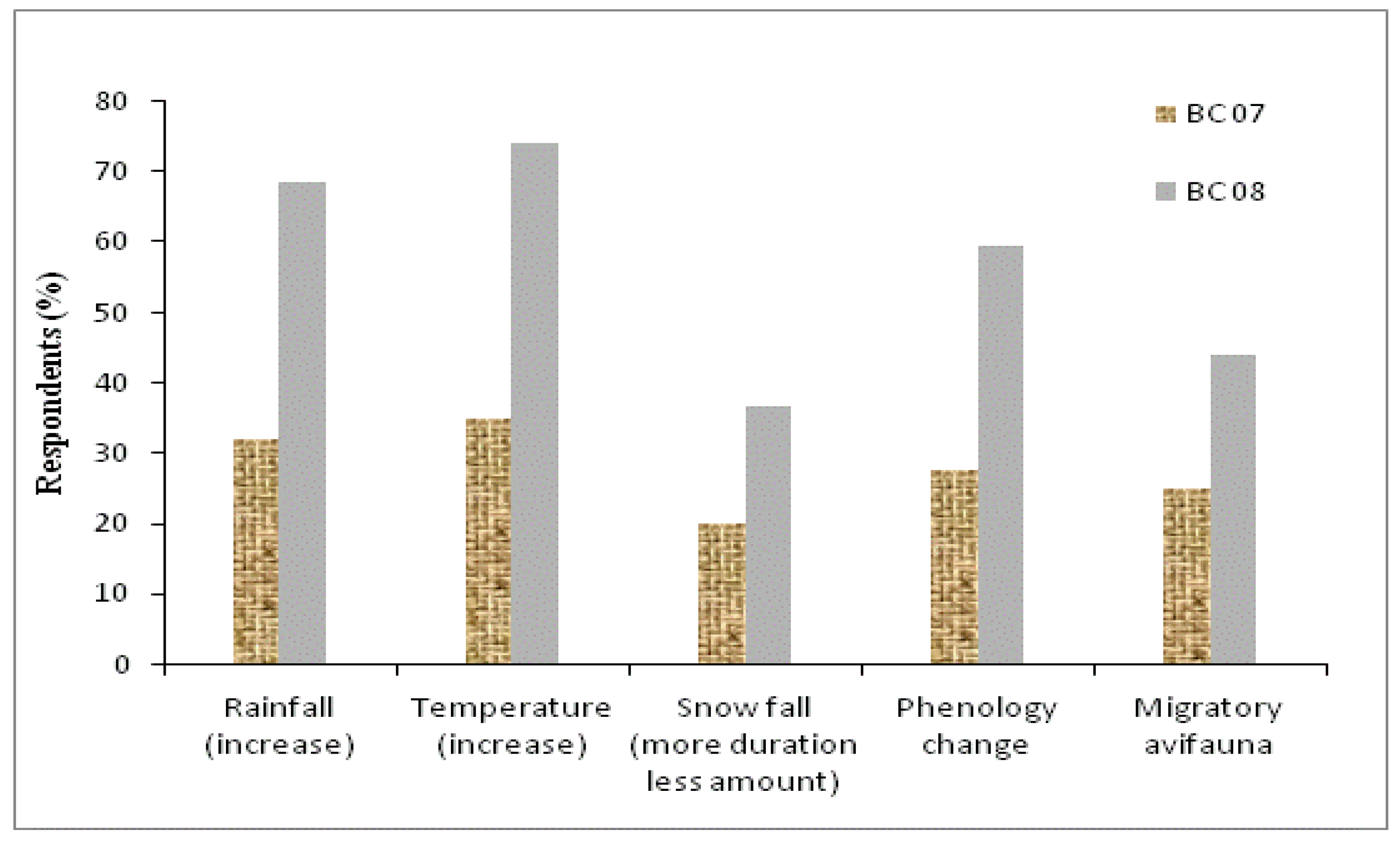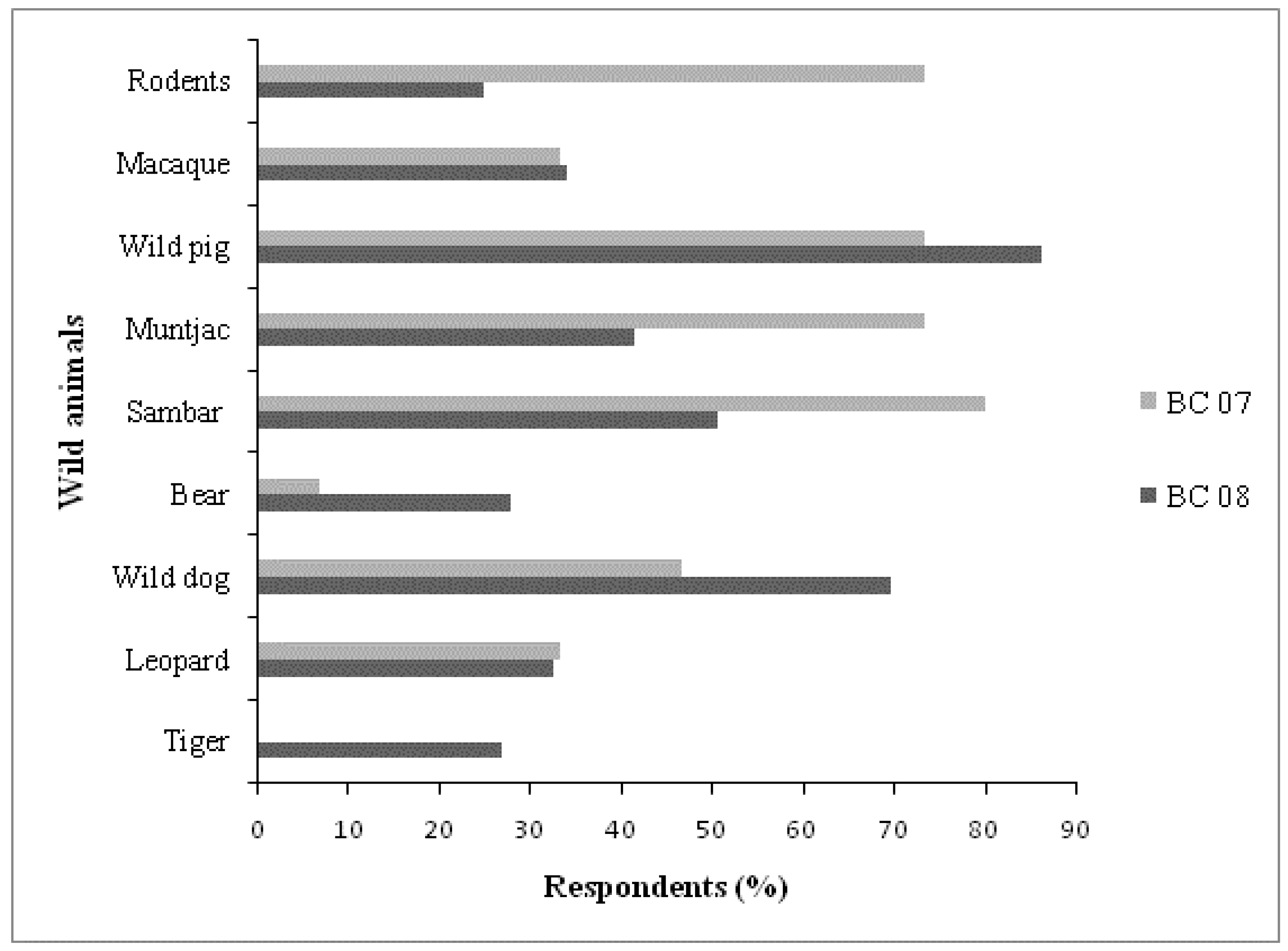Farmers’ Perceptions of Climate Change and Its Socio-Ecological Consequences in Bhutan’s Biological Corridor Network
Abstract
:1. Introduction
2. Methods
2.1. Study Area
2.2. Data Collection
2.3. Determining Social Vulnerability
2.4. Determining the Severity of Climate Change Impact
2.5. Determining Climate Change Adaptation
3. Results and Discussions
3.1. Farmers’ Knowledge and Sensitivity to Climate Change
3.2. Climate Change Impact on the Livelihood
3.3. Farmer-Wildlife Interactions under Climate Change
3.4. Climate Change Adaptation Strategy
4. Conclusions and Policy Implications
Author Contributions
Funding
Institutional Review Board Statement
Informed Consent Statement
Data Availability Statement
Acknowledgments
Conflicts of Interest
References
- Dumenu, W.K.; Obeng, E.A. Climate change and rural communities in Ghana: Social vulnerability, impacts, adaptations and policy implications. Environ. Sci. Policy 2015, 55, 208–217. [Google Scholar] [CrossRef]
- IPCC. Climate Change 2001: Impacts, Adaptation, and Vulnerability; Contribution of Working Group II to the Third Assessment Report of the Intergovernmental Panel on Climate Change; Cambridge University Press: New York, NY, USA, 2001; p. 1032. [Google Scholar]
- IPCC. International Panel on Climate Change; IPCC: Geneva, Switzerland, 2007. [Google Scholar]
- Beaumont, L.J.; Pitman, A.; Perkins, S.; Zimmermann, N.E.; Yoccoz, N.G.; Thuiller, W. Impacts of Climate Change on the world’s most exceptional ecoregions. Proc. Natl. Acad. Sci. USA 2011, 108, 2306–2311. [Google Scholar] [CrossRef] [PubMed]
- Dinar, A.; Hassan, R.; Mendelsohn, R.; Benhin, J. Climate Change and Agriculture in Africa: Impact Assessment and Adaptation Strategies; Earthscan: London, UK, 2008; pp. 100–106. [Google Scholar]
- McCarthy, J.; Canziani, O.F.; Leary, N.A.; Dokken, D.J.; White, C. (Eds.) Climate Change 2001: Impacts, Adaptation, and Vulnerability; Contribution of Working Group II to the Third Assessment Report of the Intergovernmental Panel on Climate Change; Cambridge University Press: Cambridge, UK, 2001. [Google Scholar]
- Chogyel, N.; Kumar, L. Climate change and potential impacts on agriculture in Bhutan: A discussion of pertinent issues. Agric. Food Secur. 2018, 7, 79. [Google Scholar] [CrossRef]
- Pearce, D.; Cline, W.; Achanta, A.; Fankhauser, S.; Pachauri, R.; Tol, R.; Vellinga, P. The social costs of climate change: Greenhouse damage and benefits of control. In Climate Change 1995: Economic and Social Dimensions of Climate Change; Bruce, J., Lee, H., Haites, E., Eds.; Cambridge University Press: Cambridge, UK, 1996. [Google Scholar]
- McClean, C.J.; Lovett, J.C.; Küper, W.; Hannah. L.; Sommer, J.H.; Barthlott, W.; Termansen, M.; Smith, G.F.; Tokumine, S.; Taplin, J. African Plant Diversity and Climate Change. Ann. Mo. Bot. Gard. 2005, 92, 139–152. [Google Scholar]
- Worboys, G.L. Large scale connectivity conservation in mountains: A critical response to climate change. 2008. In Proceedings of the International Workshop on Protected Area Management and Biodiversity Conservation, East Asia, Taipei, Taiwan, 2–3 September 2008. [Google Scholar]
- Hickling, R.; Roy, D.B.; Hill, J.K.; Fox, R.; Thomas, C.D. The distribution of taxonomic groups are expanding pole wards. Glob. Chang. Biol. 2006, 12, 450–455. [Google Scholar] [CrossRef]
- NEC. Bhutan State of the Environment; National Environment Commission, Royal Government Bhutan: Thimphu, Bhutan, 2016; ISBN 978-99936-865-5-2. [Google Scholar]
- Pandit, M.K.; Sodhi, N.S.; Koh, L.P.; Bhaskar, A.; Brook, B.W. Unreported yet massive deforestation driving loss of endemic biodiversity in Indian Himalaya. Biodivers. Conserv. 2007, 16, 153–163. [Google Scholar] [CrossRef]
- RGoB. Report on the Impact of Climate Change on Biodiversity and Livelihood in Toorsa Strict Nature Reserve—Jigme Dorji National Park Northern Biological Corridor; Department of Forests and Park Services, Ministry of Agriculture and Forests: Thimphu, Bhutan, 2011. [Google Scholar]
- RGoB. Forests and Nature Conservation Rules and Regulations; Department of Forests and Park Services, Ministry of Agriculture and Forests: Thimphu, Bhutan, 2017. [Google Scholar]
- RGoB. Forest and Nature Conservation Act; Department of Forests Services, Ministry of Agriculture, Royal Government of Bhutan: Thimphu, Bhutan, 1995. [Google Scholar]
- NSB. National Statistics Bureau, Royal Government of Bhutan. 2022. Available online: https:www.nsb.gov.bt/bhutan-interactive-data-portal/population (accessed on 3 April 2023).
- Namgyel, U.; Siebert, S.F.; Belsky, J.M. Participation and Governance Challenges along the Nabji Community-Based Ecotourism Trail in Bhutan; Bhutan Ecological Society, Royal Government of Bhutan: Thimphu, Bhutan, 2014. [Google Scholar]
- Nyaupane, G.P.; Thapa, B. Perceptions of Environmental Impacts of Tourism: A Case Study at ACAP, Nepal. Int. J. Sustain. Dev. World Ecol. 2006, 13, 51–61. [Google Scholar] [CrossRef]
- UNDP. Bhutan Vulnerability Baseline Assessment; UNDP: Thimphu, Bhutan, 2016. [Google Scholar]
- MoAF (Ministry of Agriculture and Forests). Drivers of Deforestation and Forest Degradation in Bhutan; Department of Forests and Park Services, Ministry of Agriculture & Forests, Royal Government of Bhutan: Thimphu, Bhutan, 2017. [Google Scholar]
- Kemausuor, F.; Dwamena, E.; Bart-Plange, A.; Kyie-Baffour, N. Farmers’ perception of climate change in the Ejura-Sekyedumase district of Ghana. ARPN J. Agric. Biol. Sci. 2011, 6, 26–37. [Google Scholar]
- Funk, C.; Dettinger, M.D.; Michaelsen, J.C.; Verdin, J.P.; Brown, M.E.; Barlow, M.; Hoell, A. Warming of the Indian Ocean threatens eastern and southern African food security but could be mitigated by agricultural development. Proc. Natl. Acad. Sci. 2008, 105, 11081–11086. [Google Scholar] [CrossRef] [PubMed]
- Tenzin, J.; Phuntsho, L.; Lakey, L. Climate smart agriculture: Adaptation & mitigation strategies to climate change in Bhutan. In Climate Smart Agriculture: Strategies to Respond to Climate Change; Shrestha, R.B., Boktiar, S., Eds.; SAARC Agriculture Centre: Dhaka, Bangladesh, 2019; pp. 37–61. [Google Scholar]
- DoA. Agriculture Statistics 2015; Department of Agriculture, Ministry of Agriculture and Forests, Royal Government of Bhutan: Thimphu, Bhutan, 2015. [Google Scholar]
- Lhendup, P.; Wikramanayake, E.; Freeman, S.; Sindorf, N.; Gyeltshen, K.; Forrest, J. Climate Change Vulnerability Assessment of Wangchuck Centennial Park, Bhutan; World Wildlife Fund (WWF); Wangchuck Centennial Park (WCP): Thimphu, Bhutan, 2011. [Google Scholar]
- Wang, S.W.; Macdonald, D.W. Livestock predation by carnivores in Jigme Singye Wangchuck National Park, Bhutan. Biol. Conserv. 2006, 129, 558–565. [Google Scholar] [CrossRef]




| Crops and Livestock | Sub-District (Gewogs) | Agroecological Zones | Mean Annual Rainfall (mm) | Mean Annual Temp. (°C) | Altitude Range (m) |
|---|---|---|---|---|---|
| Yak, buckwheat | Sephu, Gangtey, Phobji, Kazhi Chumey, Chokhor, | Alpine | <650 | 5.5 | 3600–7500 |
| Yak, buckwheat, wheat, cattle, horse, sheep, potato, vegetable, | Sephu, Gangtey, Phobji, Kazhi, Nyisho, Dangchu, Athang, Bjenag, Chumey, Chokhor | Cool temperate | 650–850 | 9.9 | 2600–3600 |
| Vegetable, potato, cattle, horse, pulse, fruit, buckwheat, wheat | Nubi, Tangsibji, Langthil, Kazhi, Dangchu, Nyisho, Athang, Bjenag, Minjay, Menbi, Gangzur, Khoma | Warm temperate | 650–850 | 12.5 | 1800–2600 |
| Maize, paddy, vegetable, potato, pulse, fruit, local cattle, exotic cattle (Jersey), horse, poultry, piggery | Nubi, Tangsibji, Langthil, Dangchu, Nyisho, Athang, Bjenag, Minjay, Menbi, Gangzur, Khoma | Dry sub-tropical | 850–1200 | 17.2 | 1200–1800 |
| Minjay, Menbi, Khoma, Gangzur, Bjenag, Nubi, Tangsibji, Langthil | Humid sub-tropical | 1200–2500 | 19.5 | 600–1200 |
| Category of Impact Intensity | Definition |
|---|---|
| Severe impact | Severe impact is defined as loss/damage of properties or lives within the specified range in the last ten year: human lives (1 people and above), agriculture crop damage (2.1–5 acres or more), house damage (completely demolished), and livestock loss (3–5 heads/more), land washed away in floods (2.1 acres or more). |
| Moderate impact | Moderate impact is defined as loss/damage of properties excluding human life within the specified range in the last ten year: agriculture crop damage (1–2 acres), house damage by flood (partially or 50% demolished), livestock loss (1–2 heads), land washed away in floods (1–2 acres). |
| Low impact | Low impact is defined as loss/damage of properties excluding human life within the specified range in the last ten year: agriculture crop damage (less than 1 acre), house damage (1/3 demolished), livestock loss (1 head), land washed away in floods (less than 1 acre). |
Disclaimer/Publisher’s Note: The statements, opinions and data contained in all publications are solely those of the individual author(s) and contributor(s) and not of MDPI and/or the editor(s). MDPI and/or the editor(s) disclaim responsibility for any injury to people or property resulting from any ideas, methods, instructions or products referred to in the content. |
© 2023 by the authors. Licensee MDPI, Basel, Switzerland. This article is an open access article distributed under the terms and conditions of the Creative Commons Attribution (CC BY) license (https://creativecommons.org/licenses/by/4.0/).
Share and Cite
Namgyel, U.; Dorji, S.; Lee, W.-K.; Wang, S.W. Farmers’ Perceptions of Climate Change and Its Socio-Ecological Consequences in Bhutan’s Biological Corridor Network. Sustainability 2023, 15, 14517. https://doi.org/10.3390/su151914517
Namgyel U, Dorji S, Lee W-K, Wang SW. Farmers’ Perceptions of Climate Change and Its Socio-Ecological Consequences in Bhutan’s Biological Corridor Network. Sustainability. 2023; 15(19):14517. https://doi.org/10.3390/su151914517
Chicago/Turabian StyleNamgyel, Ugyen, Sangay Dorji, Woo-Kyun Lee, and Sonam Wangyel Wang. 2023. "Farmers’ Perceptions of Climate Change and Its Socio-Ecological Consequences in Bhutan’s Biological Corridor Network" Sustainability 15, no. 19: 14517. https://doi.org/10.3390/su151914517
APA StyleNamgyel, U., Dorji, S., Lee, W.-K., & Wang, S. W. (2023). Farmers’ Perceptions of Climate Change and Its Socio-Ecological Consequences in Bhutan’s Biological Corridor Network. Sustainability, 15(19), 14517. https://doi.org/10.3390/su151914517







